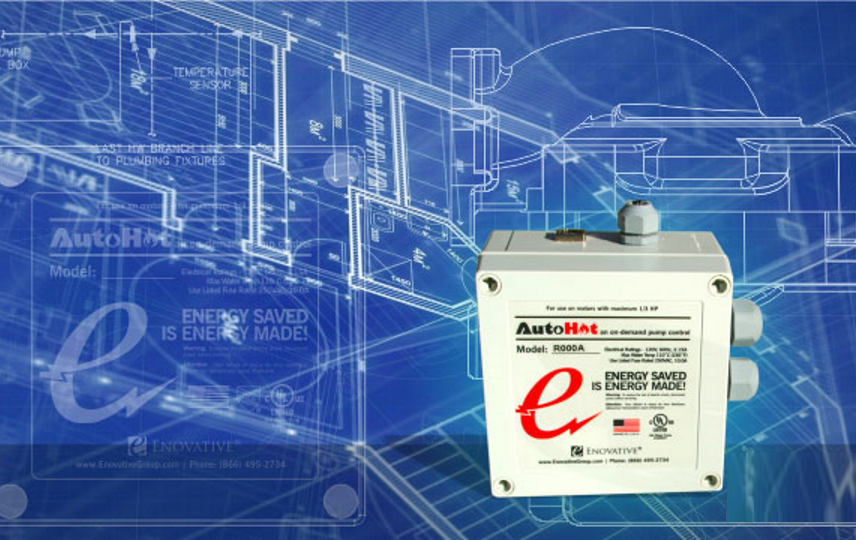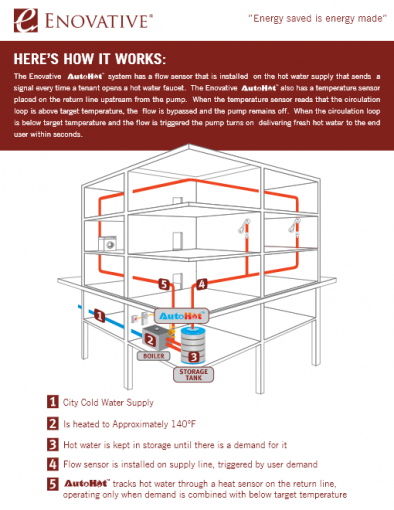
Commercial Hot Water Systems
Your tenants will love you…so will your wallet.
Commercial water heating energy use wastes 30% of its energy due to poorly controlled recirculation pumps. The AutoHot system is able to deliver hot water only when there is a demand, eliminating the waste of energy or water.

Demand Recirculation for Commercial/Multifamily Central DHW
According to research funded by the California Energy Commission, central domestic hot water systems in existing multifamily buildings are only about 35% efficient on average, with approximately one-third of the total energy being lost in the recirculation loop. Why are these recirculation loops so energy wasteful? One of the biggest contributors to these losses are the recirculation pumps, which in most cases are left running on a non-stop, 24×7 basis. This means that every minute of the day that hot water is being pumped out into the building, there is simultaneously unused return water that is being dumped back into the tank that needs to get reheated. Not only is this not necessary, but it results in excessive energy use by the heating system.
Adding Intelligence to Your Asset
Adding a commercial AutoHot® adds smart parameters that dramatically shifts any commercial or multi-unit residential building to a more efficient operation. Adding an AutoHot® to a 24/7 water recirculation system decreases pump run time from 24 hours to 1-3 hours a day, hydro (kwH) and natural gas costs plummet.
A commercial AutoHot® only runs when the recirculation water drops below a desired temperature or when demand (for even one tap) arises.
Who we work with
Not only are the landlords, owners or developers thrilled with lower operating costs and increased property value, but residents’ satisfaction and needs are met.
With AutoHot®’s smart parameters, it has the ability to continuously supply hot water without any significant run time. Residents’ needs are met with quality and efficiency, using a commercial AutoHot®.
AutoHot Commercial FAQs
How is the Enovative AutoHot® demand controller different from other typical hot water circulation pumps?
Conventional hot water circulation pumps typically operate on a continuous basis, 24/7, whether or not people are actually using hot water. This is an excessive amount of pumping as there are only two times that the pump should be circulating hot water: 1) When there is demand for hot water, and 2) When there is no hot water in the pipes. By using sensors that detect both hot water demand and loop water temperature, the Enovative AutoHot™ demand controller operates more efficiently than any other control strategy that is available.
How long does it take to install the Enovative AutoHot® demand controller?
Installation of the Enovative AutoHot® demand controller usually takes between 1-2 hours and is done by a trained plumber or boiler technician.
How does the Enovative AutoHot® demand controller reduce my water heater's fuel consupmtion?
The Enovative AutoHot® demand controller helps to reduce the amount of heat energy loss in the pipes by keeping the pump from running when it doesn’t need to. Minimizing these heat losses means that your water heater or boiler consumes less fuel to make up for these losses.
How much energy does Enovative AutoHot® demand controller save?
The Enovative AutoHot® demand controller has been proved to save 10-30% of a hot water system’s energy consumption in independent studies. These results vary from building to building depending on a number of factors, including: Building size, occupancy, pipe conditions and water heater configuration.
How does the Enovative AutoHot® demand controller reduce wear and tear on pipes?
When potable water is heated, the chemicals that are used to treat it take on more abrasive characteristics. Circulating this hot water through pipes on a continuous basis creates friction and slowly degrades the pipes from within, eventually leading to small pinhole leaks. These pinhole leaks, if not detected, can become bigger over time and create water damage to the building on top of lowering the efficiency of the water heating system. Using integrated smart controls, the Enovative AutoHot® demand controller shuts itself off when hot water delivery is not required and may operate as little as 1 hour per day, or less. This substantially reduces the amount of friction and wear on the pipes, saving you time and money on costly repairs and wasted water.
What types of buildings can the Enovative AutoHot® demand controller be used in?
The Enovative AutoHot™ demand controller can be retrofitted into any existing building that has a hot water recirculation system. Typical buildings include: Multifamily, hotels/motels, schools, dormitories, office, retail….etc. Even if the building does not have a dedicated return line, the Enovative AutoHot™ demand controller may be installed at the furthest fixture on the line and activated using motion sensors or push buttons from any fixture in the building.
How often does the the Enovative AutoHot® demand controller actually run?
This varies from building to building and is in part a function of hot water usage patterns. In many multifamily buildings, for example, the Enovative AutoHot® demand controller may run 2-3 hours per day. However, in a building that has set schedules, such as an office or school, it may run much less.
I've heard of demand controlled pumps. Is this to go under the sink of every unit, in lieu of the main recirculation pump?
Enovative does provide demand controlled pumps for residential use which can be installed under the sink. But for commercial and multifamily use, the Enovative commercial product is not like the residential version that goes under the sink. Rather, this a control system for the main recirculation pump that is located in the boiler room. Operating the pump using the AutoHot® demand controller will reduce the run time of the pump down to only about 1 hour per day total while still providing fast, safe hot water when people demand it.
What are the specs of the pump that comes with the control system?
The pump is a Grundfos model UP 26-99 BFC.
How sensitive is the flow sensor?
The flow switch that is used to sense demand in the building is triggered at flow rates of about 3.7 L per minute.
At what temperature will the temperature sensor turn the pump off?
The pump will turn off once the temperature sensor detects water temperatures of about 107 degrees on the return line.
Will this system work for a central plant, or any other pump application other than domestic hot water?
No. The AutoHot® demand controller will only work in a domestic hot water application where there is an open loop system. Closed loop systems such as chilled water and condenser water loops will not work as demand is only sensed when water is leaving the system.
Won't an aquastat work just as well?
An aquastat will automatically turn the pump off when hot water is in the loop, thus constantly keeping it hot. Whereas demand controls will shut it off when it gets hot, but then allow the pipes to cool to ambient temperatures if there is no demand. It is during these periods where most of the energy savings are being achieved.
Can this pump system be integrated into a building's Energy Management System (EMS)?
The AutoHot® demand controller is not currently able to interface with an EMS, but changes are being made so that in the near future this will be possible.
What kind of maintenance is required, and what is the warranty?
Since the pipe temperatures are fluctuating quite a bit under demand controlled recirculation, doesn't this constant expansion and contraction of the pipes eventually lead to pipe degradation?
The expansion rate of copper under the temperature changes that are typical in a domestic system (50-150 degrees F) is so small, that it barely represents the width of a human hair. If this expansion and contraction of the pipes were a legitimate maintenance issue, it would be epidemic as most households do not have any recirculation at all. Needless to say, most issues related to hot water pipe failures is due to bad plumbing, continuous recirculation or a combination of both.


